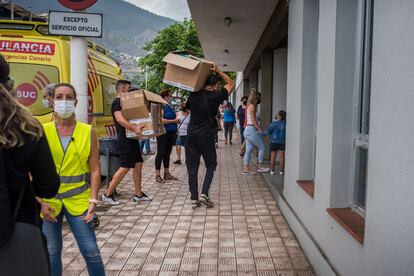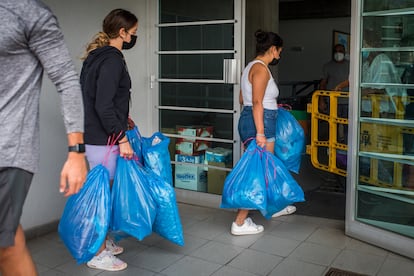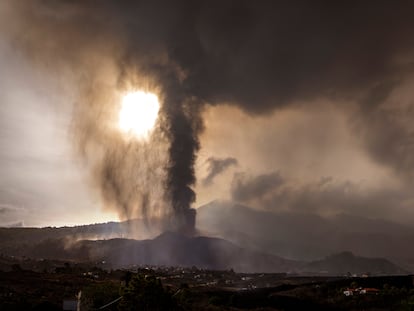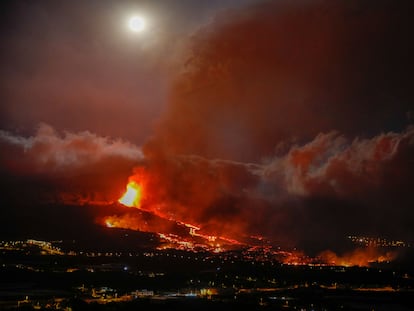Distress and uncertainty take hold in La Palma: ‘We’ve lost our whole life’
Locals evacuated from their homes following the eruption on the Canary Island do not know yet know whether the lava has destroyed their houses, nor when they will be able to return


“Everyone is devastated here. If they’re not depressed they’re on the brink.” The person speaking is Jonay Pérez. He’s not just the security councilor at the council in El Paso, the municipality on the Canary Island of La Palma where a new volcano erupted on Sunday. He is also a local resident, having lived in El Paraíso since he was born. The area was completely razed on Monday by a tongue of lava, which swept away houses, estates and businesses on its slow journey down the hillside.
One of the stores that it destroyed belonged to his mother. “She’s lost five kilos in two days,” he explains. “Her store is completely buried. The lava went right over the top of it.” Jonay’s mother’s grocery store contained €30,000 worth of stock when the lava arrived. But that’s just money. “Most of us were born there,” he adds. “We’ve lost our whole life.”
Jonay’s situation is similar to that of hundreds of families in other areas, such as Todoque, in the bordering municipality of Los Llanos de Aridane, home to 20,170 inhabitants. The distress is growing with the “inexorable” advance, in the words of the Canarian regional premier, Ángel Víctor Torres, of the two lava flows that have emerged from the volcano, and that have already swallowed up nearly 400 homes.

The team of experts monitoring the phenomenon, the Volcano Risk Prevention Plan (Pevolca), reports that the lava is now covering an area of around 140 hectares, with a front measuring 600 meters. Pevolca’s technical director, Miguel Ángel Morcuende, explained on Wednesday that the two rivers of lava are still advancing, “but very slowly,” given the rise in viscosity and the conditions of the terrain. “We cannot be sure that the lava will reach the sea,” he said. The Cabeza de Vaca volcano, for now, is only showing one fissure, with nine vents, albeit not all of them currently spewing out lava.
The 5,600 people evacuated so far have managed to find shelter mostly in the houses of relatives. The 200 or so who had nowhere to go were first housed in El Fuerte barracks, on the outskirts of the capital, Santa Cruz de La Palma, which is home to 15,695 residents. Premier Torres announced on Wednesday that these people would soon be rehoused in a hotel in Fuencaliente, in the southwest of the island. People with disabilities or mobility problems will be transferred to care centers.
Many break down and cry; they are people of all ages and they’ve lost everythingNines, a social worker at Los Llanos local council
“There are people who are arriving resigned [to the situation],” explains Nines, a social worker at Los Llanos local council, in the municipal sports center in which all of the food and clothing donated by the public is being organized. “Many break down and cry; they are people of all ages and they’ve lost everything,” she explains.
Nines’ task is to register all of the people who have been left without a home and determine whether or not they have been rehoused. “Yesterday, we had to attend to a case of angina in a woman who had come to ask for help.”
The biggest uncertainty for residents is not knowing how long this situation will last, nor how it will end. There are some who still don’t even know what happened to their house. That’s the case of Dolores (not her real name), who came to the sports center to request food and clothing. She is from Todoque, where the lava arrived on Tuesday, and she is convinced that she has lost her home. But she is unable to confirm this given that she can’t reach the area. “It’s my whole life,” she says. “My parents lived there, I was born there…”
If the present is distressing the residents of La Palma – one of Spain’s Canary Islands, which are located in the Atlantic Ocean off the northwestern coast of Africa – the future is the same color as the ashes that the new volcano is spitting out. “Within two months, when this is over and the rest of Spain forgets about us, our heads are going to explode,” says one council worker from El Paso, who also spoke on the condition of anonymity. “Let’s wait a few months to see what happens.” “God doesn’t exist in El Paso,” says Rosa, a local resident. “A month ago there was a fire, and now this…”
Concern about the future
Both the Spanish prime minister, Pedro Sánchez, and the Canary Islands premier, Ángel Víctor Torres, have been at pains to state that no one will be left out of the reconstruction of the island. Torres announced on Tuesday that he will request assistance from the European Union. And the central government has begun to design a specific plan that will help speed up the arrival of aid and adapt to the exceptional circumstances of this, the first volcanic eruption in Spain since 1971. This will include the reconstruction of homes and infrastructure, fiscal measures for affected citizens and companies, and specific measures and subsidies for fishing and agriculture, which are the main economic drivers for the island apart from tourism.
If and when this help will arrive is a source of great concern for the residents. “My mother is planning on requesting assistance from the state so that she can, somehow, reopen her business,” explains Jonay Pérez. The lava avoided the houses of other residents, but some still don’t want to return to homes in a place that they now imagine to be devastated and cut off. “We are a big family here,” says one man. “I was talking to a resident. Her house has been saved, but she doesn’t want to set foot in El Paraíso again.” The Canary Islands government announced on Wednesday that it would be buying 44 empty homes in Tazacorte and another 29 in Los Llanos de Aridane.
In the meantime, no expense is being spared on the efforts to reduce the damage being caused by the lava, even if they end up being in vain. After evacuating the area in Todoque, a group of firefighters from the Canary Island of Gran Canaria spent Wednesday morning digging trenches using heavy machinery, according to the group chief, Alberto Barrio. “Our superiors began to think about possibilities, and they based them on experiences that had been carried out in Finland or the volcano in Iceland,” he explains via phone conversation. “And as we don’t know how to just do nothing, we got to work. We could have done it earlier, but it might not end up doing anything. But we had to try.”
English version by Simon Hunter.
Tu suscripción se está usando en otro dispositivo
¿Quieres añadir otro usuario a tu suscripción?
Si continúas leyendo en este dispositivo, no se podrá leer en el otro.
FlechaTu suscripción se está usando en otro dispositivo y solo puedes acceder a EL PAÍS desde un dispositivo a la vez.
Si quieres compartir tu cuenta, cambia tu suscripción a la modalidad Premium, así podrás añadir otro usuario. Cada uno accederá con su propia cuenta de email, lo que os permitirá personalizar vuestra experiencia en EL PAÍS.
¿Tienes una suscripción de empresa? Accede aquí para contratar más cuentas.
En el caso de no saber quién está usando tu cuenta, te recomendamos cambiar tu contraseña aquí.
Si decides continuar compartiendo tu cuenta, este mensaje se mostrará en tu dispositivo y en el de la otra persona que está usando tu cuenta de forma indefinida, afectando a tu experiencia de lectura. Puedes consultar aquí los términos y condiciones de la suscripción digital.
More information
Últimas noticias
Welcome to the post-religion era: The idea of Christianity as the absolute truth has become obsolete
‘I thought you would like it’: The risky sexual practice popularized by TV shows and TikTok
The digitalization of tourism: ‘They promise experiences and gave us the worst possible one’
Mexican peso defies uncertainty with forecasts of a new period of stability in 2026
Most viewed
- Sinaloa Cartel war is taking its toll on Los Chapitos
- Oona Chaplin: ‘I told James Cameron that I was living in a treehouse and starting a permaculture project with a friend’
- Reinhard Genzel, Nobel laureate in physics: ‘One-minute videos will never give you the truth’
- Why the price of coffee has skyrocketed: from Brazilian plantations to specialty coffee houses
- Silver prices are going crazy: This is what’s fueling the rally










































